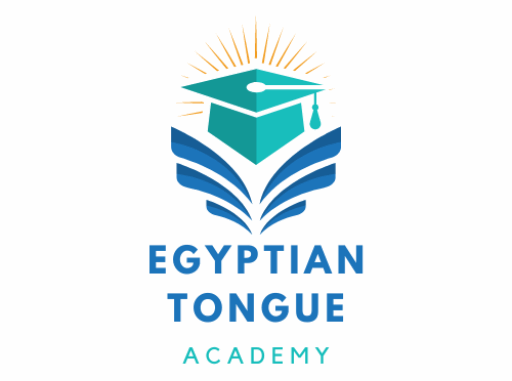The Secret Guide to (Is Arabic Hard To Learn?) – 20 Secret Steps
Is Arabic Hard to Learn? The Complete Guide to Your Arabic Journey
You’ve asked the big question: Is Arabic hard to learn? It’s a query that echoes the thoughts of countless curious minds, and if you’re feeling a mix of excitement and intimidation, know that you are not alone. Perhaps you’ve scrolled through images of intricate Arabic calligraphy and thought, “There’s no way I can ever read that.” Or maybe you’ve heard the mesmerizing sounds of Arabic spoken and worried about ever being able to pronounce the guttural ‘ayn’ or the soft ‘kha.’ These are not just common concerns—they are the exact hesitations that stop so many people from even starting. Many people wonder “is Arabic hard to learn” when they first encounter these elegant but unfamiliar scripts.
You might be picturing yourself in a language class, staring at a page of squiggly lines that look more like an ancient riddle than a simple alphabet. You’ve heard the stories: the grammar is impossibly complex, the vocabulary is vast, and the sheer number of dialects is enough to make anyone’s head spin. We get it. The journey seems like an uphill battle, shrouded in mystery and filled with obstacles. The idea of learning a language so fundamentally different from English can feel less like a rewarding challenge and more like an impossible mission. The truth is, these feelings are valid, but they don’t have to define your potential.
But what if we told you that the answer to “Is Arabic hard to learn?” is not a simple yes or no? What if the real question is how you approach it? This article isn’t here to sugarcoat the process, but it is here to debunk the myths and demystify the journey. We’re going to give you a clear, actionable roadmap that breaks down the path to fluency into manageable steps. This isn’t just another blog post; it’s a complete guide designed to give you a surprising, and highly empowering, perspective. You’ll discover that the very things that seem intimidating—the unique script, the rich sounds—are what make the language so beautiful and ultimately, so rewarding to learn.
Our goal is to transform your mindset from “impossible” to “I can do this.” We’ll walk you through the very first steps, from conquering the alphabet to mastering core vocabulary and simple sentence structures. You’ll learn the truth about the different dialects and see how you can start speaking Arabic with confidence almost immediately.
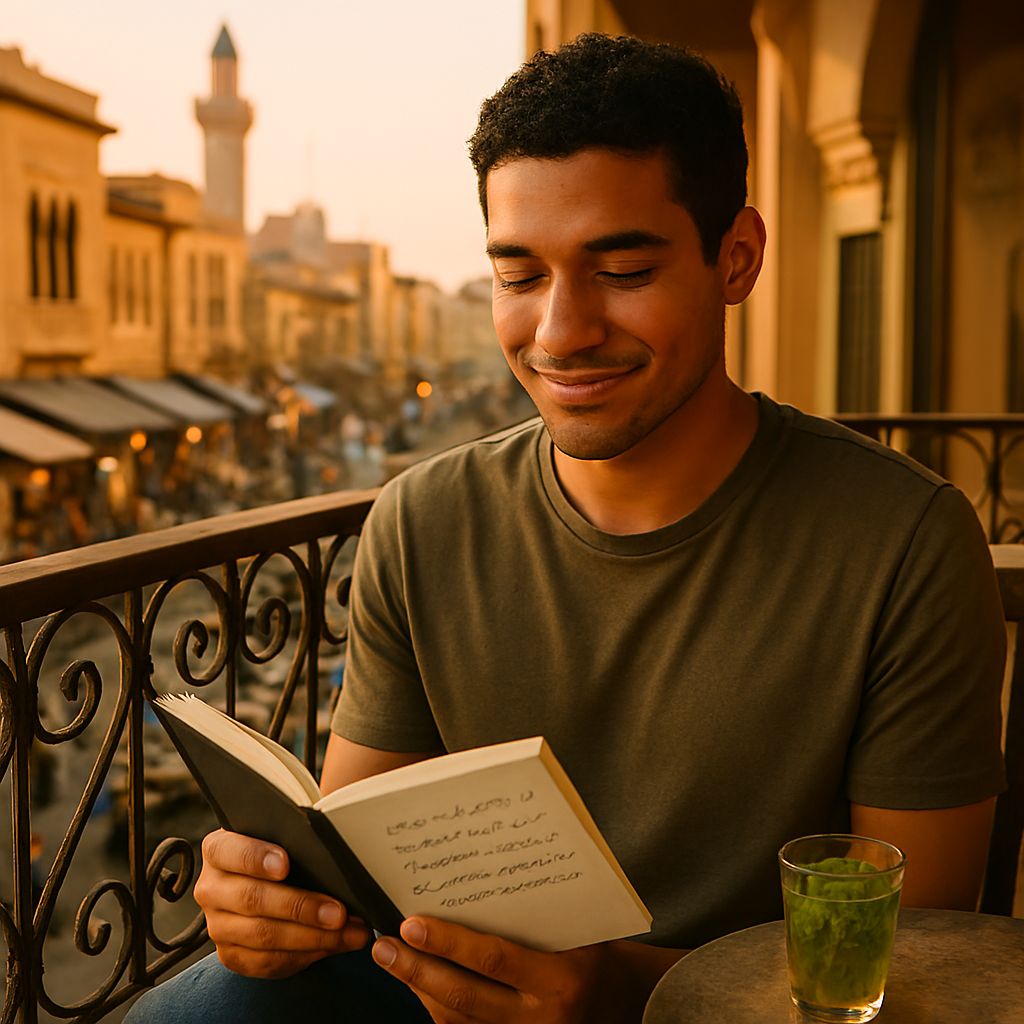
The 3 Real Challenges (and Why They’re Not Deal-Breakers)
The question “Is Arabic hard to learn?” deserves an honest, nuanced answer. The truth is, Arabic presents a unique set of challenges for native English speakers. However, the word “challenge” should not be synonymous with “impossible.” It simply means the learning path is different. With a clear map of the terrain ahead, what seems like a mountain becomes a series of manageable hills. Let’s demystify the three most common hurdles: the script, the sounds, and the structure. Before we dive deeper into why ‘is Arabic hard to learn’ remains such a common concern, let’s examine each challenge with practical solutions.
Challenge #1: The New Alphabet and Right-to-Left Reading
The persistent question “is Arabic hard to learn” often stems from this initial visual barrier. For many, the first and most visible hurdle is the Arabic script. It feels profoundly foreign. The letters are beautifully cursive, they change shape depending on their position in a word, and, most disorientingly, the text flows from right to left. This can feel like learning to write all over again.
When students first ask ‘is Arabic hard to learn,’ the script is usually their biggest worry, this concern is often overblown. But let’s break this down. The Arabic alphabet has 28 letters. While this is more than the Latin alphabet, it is a finite and manageable set. The principle of letters connecting and changing shape is logical: a letter looks one way when it stands alone, another when it connects from the right, another when it’s in the middle, and another when it’s at the end of a word. It’s a system designed for fluid, efficient writing. As for reading from right to left? This is merely a habit to be formed. Your brain is remarkably adaptable. Within a few weeks of consistent practice, reaching for the “start” of a line on the right will begin to feel natural.
Take Sarah, an enthusiastic beginner. She opened her first Arabic book and felt immediate cognitive dissonance. Her hand instinctively went to the top-left corner to start reading, but that was the “end” of the line. The letters seemed to flow into one another with no clear breaks. Initially overwhelmed, she decided to focus on just two things: memorizing the isolated form of each letter and practicing writing her name. Within days, the strange symbols started to look like distinct characters. Within two weeks, she could slowly sound out words, and the right-to-left flow began to feel less like a barrier and more like a unique dance across the page.
Recommended Tools:
- Apps: “Write It! Arabic” is an excellent app that gamifies learning the alphabet. It guides you through the stroke order and different forms of each letter with immediate feedback.
- YouTube: Search for “Arabic alphabet with audio” and you’ll find countless videos that demonstrate the pronunciation of each letter alongside its various forms. Visual and auditory learning combined is incredibly powerful for mastering the script.
Challenge #2: The “Throat” Sounds (Phonetics)
When students ask “is Arabic hard to learn,” the phonetic challenges are usually their primary concern. Arabic contains sounds that simply don’t exist in English. These are often called the “emphatic” or “guttural” sounds. They are produced deep in the throat and can be tricky for newcomers to even hear, let alone reproduce. This phonetic complexity is why many wonder ‘is Arabic hard to learn,’ yet thousands of non-native speakers master these sounds every year.
For example, the letter ع (‘ayn) is a voiced pharyngeal fricative. In simple terms, it’s a sound made by constricting the pharynx (the part of your throat behind your mouth) and creating a voiced, friction-like sound. It is not a glottal stop (like the catch in “uh-oh”). Then there’s ح (ḥā), a voiceless pharyngeal fricative—the unvoiced, breathier cousin of ‘ayn. Another classic challenge is ق (qāf), a voiceless uvular stop, which is produced by raising the back of the tongue to the uvula (that little punching bag in the back of your throat), not with the soft palate as in the English “k.”
Mastering these sounds is less about brute force and more about careful listening and muscle memory. It’s a physical skill, like learning to whistle.
Mark, a dedicated student, struggled for weeks with ع and ح. To his ear, they sounded almost identical. His teacher told him to place his fingers lightly on his Adam’s apple. For ع, he should feel a strong vibration (voiced); for ح, he should feel only a puff of air (voiceless). He spent hours listening to native speakers on Forvo and mimicking them in front of a mirror, watching the position of his tongue and throat. It was frustrating, but one day, it just clicked. The muscle memory formed, and he could produce a clear, distinct ع. The victory was immense.
Recommended Tools:
- Website: Forvo.com is an indispensable pronunciation dictionary. You can type any Arabic word and hear it pronounced by native speakers from different countries. Listen to a single word repeated by a dozen people to train your ear.
Challenge #3: The Root System & Verb Conjugations
The complexity behind “is Arabic hard to learn” becomes clearer when examining this systematic approach to word formation. If the alphabet and sounds are the body of the language, the root system is its soul. This is arguably the most intellectually fascinating aspect of Arabic, but also the one that requires a significant shift in thinking. Arabic words are built around a system of (usually) three-letter roots that convey a core meaning.
For example, the root ك-ت-ب (k-t-b) carries the core idea of “writing.” From this root, we can derive:
- كَتَبَ (kataba) = He wrote
- كِتاب (kitāb) = A book (the thing that is written)
- مَكْتَب (maktab) = A desk or office (the place of writing)
- كَاتِب (kātib) = A writer (the person who writes)
Understanding this system transforms the answer to ‘is Arabic hard to learn’ from intimidating to fascinating. Once you know a root, you can often deduce the meaning of new words. Verb conjugations are also highly structured and based on patterns. While there are many forms, they are all built on consistent, logical rules. This means that after an initial investment in understanding the system, your ability to acquire and recognize vocabulary expands exponentially.
After a year of study, Aisha felt she had hit a vocabulary wall. She was memorizing lists of disjointed words. Her tutor then introduced her to the root system. It was a revelation. She started keeping a notebook organized by roots instead of by themes. Suddenly, seeing the word for “teacher” (مُدَرِّس, mudarris) and noticing the root د-ر-س (d-r-s for “to study”) helped her connect it to “school” (مَدْرَسَة, madrasa) and “lesson” (دَرْس, dars). Learning became a process of discovery rather than rote memorization.
Recommended Tools:
- Website: Qutrub (qutrub.arabeyes.org) is a powerful, free online Arabic verb conjugator. You enter the root, and it will generate all conjugations for you. It’s an excellent tool for checking your work and seeing patterns.
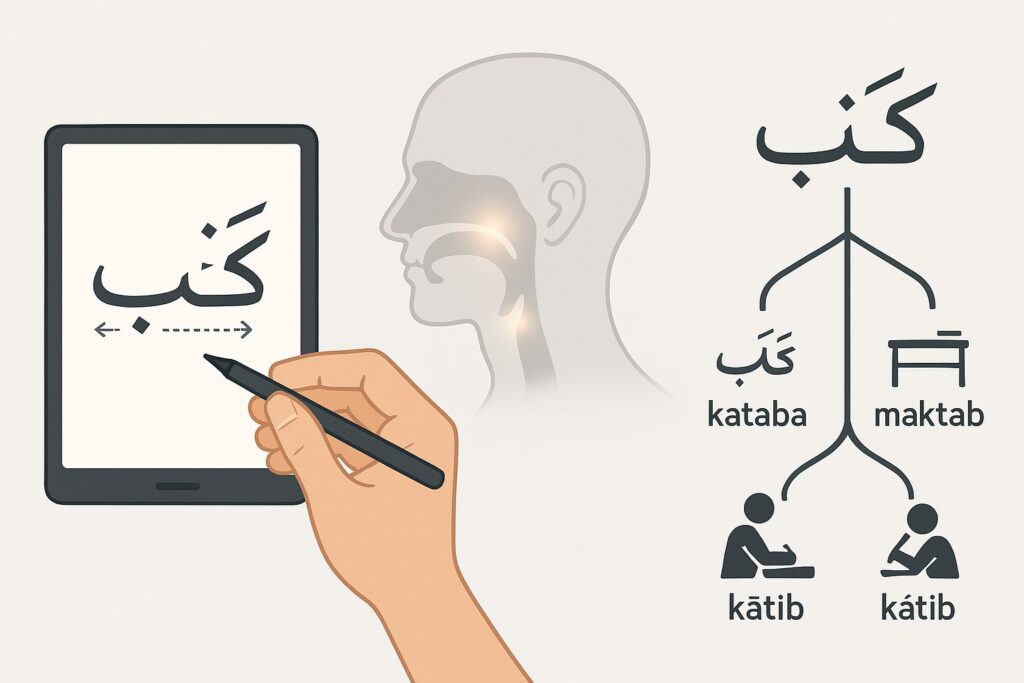
3 Surprising Reasons Arabic Can Be Easier Than Other Languages
Is Arabic hard to learn? This question often stems from perceptions of complexity, but our analysis shows that Arabic possesses several surprisingly approachable features. Understanding these strengths can help you overcome common hurdles and showcase why Arabic can be a rewarding language to learn. Those who ask “is Arabic hard to learn” are often surprised to discover these advantageous features. If you’ve been asking ‘is Arabic hard to learn,’ these three advantages will surprise you and boost your confidence.
Surprise #1: Incredibly Consistent and Logical Grammar
Contrary to popular belief, Arabic grammar is highly consistent and logical, often making it easier for beginners to grasp than English grammar. Here’s how Arabic compares to English in key areas:
| Aspect | Arabic | English |
|---|---|---|
| Grammar Consistency | Highly regular patterns with predictable rules | Many exceptions and irregular forms |
| Verb Conjugation | Based on root patterns with clear formulas | Irregular verbs and multiple tenses to memorize |
| Noun Gender | Two genders (masculine & feminine) with clear markers | No grammatical gender for most nouns |
| Definite Article | A single definite article (ال) attached to words | Uses “the” but with exceptions and usage rules |
| Sentence Structure | Flexible word order, often VSO (Verb-Subject-Object) or SVO | Mostly fixed SVO (Subject-Verb-Object) order |
This consistency is why experienced language teachers often tell students that ‘is Arabic hard to learn’ is the wrong question—it should be ‘how logical is Arabic to learn?
Deep Analysis of Key Grammar Points:
Grammar Consistency: Arabic follows highly regular patterns with predictable rules, while English has numerous exceptions and irregular forms. Arabic’s consistency allows beginners to form a strong foundation quickly without being bogged down by exceptions.
Verb Conjugation: Arabic verbs are constructed around three-letter roots, with modifications applied according to clear patterns to express tense, mood, and voice. This root pattern system allows learners to recognize and predict verb forms logically. English verbs follow less predictable patterns, with significant irregular forms like “go/went” or “buy/bought” that must be memorized individually.
Sentence Structure: Arabic sentence structure is notably flexible. While verb-subject-object (VSO) is common, the language also frequently uses subject-verb-object (SVO) order and allows for rearrangements depending on focus and emphasis. English relies mostly on a fixed SVO structure. This flexibility in Arabic accommodates different linguistic expressions without strict syntactic hurdles, making it easier for learners to form correct sentences and experiment with expression sooner.
Surprise #2: A Simpler Writing System (No Capital Letters)
The answer to “is Arabic hard to learn” becomes more positive when considering this streamlined approach. Another approachable feature of Arabic is its writing system. Unlike English and many other languages, Arabic has no capital letters. This absence simplifies the learning process because learners do not need to memorize separate uppercase and lowercase letter forms or rules around capitalization. The Arabic alphabet consists of 28 letters, and while the forms of letters change depending on their position in a word, once learners master these variations, reading and writing become fluid and consistent. When beginners discover this simplicity, their perspective on ‘is Arabic hard to learn’ shifts dramatically toward the positive.
Arabic script is also cursive by nature, meaning letters connect in flowing shapes that help maintain reading rhythm. Additionally, vowels in Arabic are often indicated by diacritical marks, which can be omitted in advanced texts but present in learning materials to help beginners properly pronounce words. This system balances simplicity and clarity, especially for new learners.
Surprise #3: A Bridge of Familiarity (Arabic Loanwords in English)
Students frequently ask “is Arabic hard to learn” without realizing how many Arabic words they already know. One often overlooked fact that makes learning Arabic more approachable is the presence of numerous Arabic loanwords in English. These shared words provide learners with familiar touchpoints that can boost vocabulary acquisition. Here are common Arabic loanwords used in English. These familiar words provide an encouraging answer to ‘is Arabic hard to learn’—you already know more Arabic than you think.:
Alcohol, Alchemy, Coffee, Cotton, Guitar, Lemon, Magazine, Syrup, Sugar, Artichoke, Mattress, Safari, Saffron, Caliber, Tariff
Interesting Etymologies:
- Alcohol: Originates from the Arabic “al-kuḥl,” which originally referred to a fine powder used as an eyeliner before evolving to mean distilled substances.
- Coffee: Traced to the Arabic word “qahwa,” referring to the brewed beverage that spread from the Arab world to Europe and beyond.
- Guitar: Likely derived from the Arabic “qīṯārah,” a term for a stringed instrument, connecting the cultural exchange of musical traditions.
These linkages not only make parts of Arabic vocabulary feel more familiar to learners but also demonstrate the historical and cultural connections between languages.
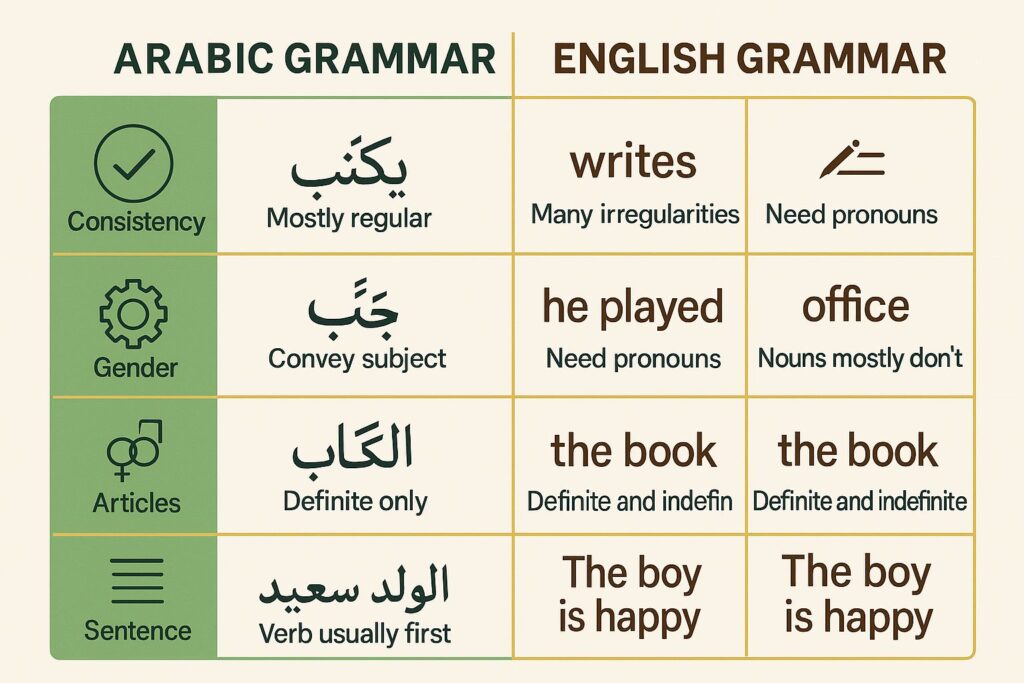
From Zero to Confident: Your 20-Step Action Plan
The practical answer to “is Arabic hard to learn” lies in following a structured, step-by-step approach. So, you’ve been wondering, “Is Arabic hard to learn?” and the answer you’ve found is nuanced. Yes, it presents unique challenges, but no, it is not an insurmountable mountain reserved for a select few. The true answer lies not in the language itself, but in your approach. The question isn’t if it’s hard, but how you can master it effectively. The key is a structured, motivating, and action-driven plan that transforms the journey from a daunting question into an exhilarating daily adventure. This is your blueprint. Follow these 20 steps, and you will build your Arabic competence from the ground up, with confidence and clarity. Instead of continuing to wonder ‘is Arabic hard to learn,’ follow this proven roadmap that has guided thousands of successful learners.
Phase 1: Master the Foundation (Steps 1-5)
Students who ask ‘is Arabic hard to learn’ often skip this foundation phase, which is why they struggle later. This initial phase is non-negotiable. It’s about building your linguistic house on solid rock, not sand. Investing time here will make every subsequent step exponentially easier and faster.
Step 1: Embrace the Arabic Script, Don’t Fear It The Arabic alphabet is your gateway. Seeing it as a puzzle to solve, not a barrier to entry, changes everything. Mastering the 28 letters unlocks the ability to sound out any word, read signs, menus, and headlines, granting you immediate access to the language’s written world.
Start with the isolated forms. Use apps like “Write It! Arabic” or physical flashcards. Write each letter repeatedly, saying its name and primary sound aloud. For example, practice ج (jeem), making the /j/ sound as in “jam,” and ب (baa), making the /b/ sound. Dedicate 15 minutes daily to this; within two weeks, you’ll recognize them all. This mindset shift answers ‘is Arabic hard to learn’ with confidence rather than fear.
Step 2: Conquer Letter Connections Letters change shape depending on their position in a word (initial, medial, final, isolated). This is the single biggest hurdle for beginners, but conquering it makes reading fluid and intuitive.
Take 5-10 letters and learn their four forms. Use a simple three-letter root like ك-ت-ب (K-T-B, relating to writing). See how it forms كَتَبَ (kataba, he wrote). Notice how the ت (taa) is in its medial form, connected on both sides. Practice writing your name, imagining how each letter would connect.
Step 3: Decode the Sound System Arabic has sounds that don’t exist in English, like ع (ayn) and ح (haa). Proper pronunciation from day one prevents fossilized errors and ensures you’re understood.
Many who ask ‘is Arabic hard to learn’ are specifically worried about pronunciation, making this step crucial. Listen and mimic. YouTube is your best friend. Search for “Arabic pronunciation guides.” Watch a native speaker’s mouth and tongue placement. Practice the difference between ه (haa – a light exhale) and ح (haa – a constricted sound from the throat). Don’t just hear the difference; feel it.
Step 4: Learn the “Smile-Friendly” Phrases Language is for connection. Learning high-impact, positive phrases from day one builds immediate confidence and provides a tool for real human interaction, which is the ultimate motivator.
Memorize and practice: مرحبا (marhaba – Hello), من فضلك (min fadlak – please), شكرا (shukran – thank you), عفوا (‘afwan – you’re welcome), أهلا وسهلا (ahlan wa sahlan – a warm welcome). Say them out loud until they roll off your tongue.
Step 5: Label Your World This builds passive vocabulary effortlessly and creates a constant, low-effort immersion environment. It moves words from your study time into your daily life, reinforcing memory through context. This technique shows that ‘is Arabic hard to learn’ becomes less relevant when Arabic becomes part of your daily environment.
Grab a pack of sticky notes. Write the Arabic word for everyday items and stick them on them: باب (baab – door), نافذة (naafidha – window), طاولة (taawila – table), كتاب (kitaab – book). See the word, say it aloud, and use the object multiple times a day.
Phase 2: Build Your Vocabulary Core (Steps 6-12)
With the script under your belt, it’s time to fill your mental dictionary with the most essential building blocks. We focus on frequency and utility. The question ‘is Arabic hard to learn’ transforms into ‘how fast can I build my Arabic vocabulary?’ with these proven strategies.
Step 6: Target the 100 Most Common Words These words make up a huge percentage of everyday conversation. Knowing them allows you to grasp the gist of dialogues and simple texts much faster, creating a foundation of comprehension.
Find a reputable “Top 100 Arabic Words” list online or use a frequency dictionary. Focus on pronouns (أنا – ana: I, هو – huwa: he), common verbs (ذهب – dhahaba: to go, قال – qaala: to say), and core nouns (يوم – yawm: day, رجل – rajul: man). Use spaced repetition (like Anki) to memorize them.
Step 7: Weaponize Spaced Repetition (SRS) SRS is the scientifically proven method to move vocabulary from your short-term to long-term memory efficiently. It schedules reviews right before you’re about to forget, ensuring maximum retention with minimal time. This scientific approach proves that ‘is Arabic hard to learn’ depends more on method than difficulty.
Download a free app like Anki or Memrise. Create digital flashcards with the Arabic word on one side and the English meaning (and an audio clip, if possible) on the other. Commit to reviewing your deck for 10-15 minutes every single day.
Step 8: Learn in Word Families, Not Isolation Arabic is built on a root system, typically three letters that convey a core meaning. Learning by root allows you to unlock multiple words at once, turning vocabulary acquisition from memorization into a logical discovery process.
Discover a root like ك-ت-ب (K-T-B – writing). From this, you get كَتَبَ (kataba – he wrote), كِتاب (kitaab – book), مَكْتَب (maktab – office/desk), and كَاتِب (kaatib – writer). Learn these as a family.
Step 9: The Power of Themed Vocabulary Lists Our brains store information in networks. Learning all the words for “food” or “transportation” together creates a strong contextual network, making recall easier and more practical for real-life situations.
Pick a theme relevant to you—e.g., “Coffee Shop.” Learn: قهوة (qahwa – coffee), كوب (kub – cup), سكر (sukkar – sugar), حليب (haleeb – milk), أريد (ureed – I want). Then, mentally practice your order: أريد قهوة مع الحليب والسكر (I want coffee with milk and sugar).
Step 10: Become a Shadow Rather than wondering ‘is Arabic hard to learn,’ shadowing proves that Arabic pronunciation and rhythm can be mastered through focused practice. Shadowing (listening and immediately repeating) trains your mouth, ears, and brain simultaneously. It dramatically improves your accent, rhythm, intonation, and listening comprehension speed.
Find a short audio clip (1-2 minutes) from a beginner podcast or textbook dialogue with a transcript. Listen to one sentence, pause, and repeat it aloud, mimicking the speaker’s tone and pace exactly. Don’t just say the words; perform them.
Step 11: Activate Your Vocabulary Daily Passive knowledge (understanding) is different from active knowledge (using). You must force yourself to produce the language to make it truly yours and usable in conversation.
Perform a “mini internal monologue” in Arabic. Look around you and describe what you see: “هذا مكتب. ذلك كتاب. أنا جائع.” (This is a desk. That is a book. I am hungry). It feels silly, but it powerfully bridges the gap between knowing a word and using it.
Step 12: Curate a “Personal Dictionary” A personalized notebook where you collect words you find interesting or useful is far more powerful than a generic list. It reflects your personal journey and interests, making review more engaging.
Use a physical notebook or a digital doc. Don’t just write the word and translation. Add the root, an example sentence, and maybe a drawing or a personal note about where you learned it. Revisit and read from this personal dictionary weekly.
Phase 3: Understand the Structure (Steps 13-20)
At this phase, ‘is Arabic hard to learn’ becomes ‘how can I express complex ideas in Arabic?’ as your skills mature. Now that you have words, it’s time to learn how to weave them into powerful, correct sentences. This is where you move from phrases to true expression.
Step 13: Demystify the “Case Endings” (I’raab) Case endings (short vowel sounds on the ends of words) indicate a word’s grammatical function in a sentence (subject, object, etc.). While modern dialects simplify this, understanding it for Modern Standard Arabic is key to precise reading and listening comprehension.
Start with the basics. Know that ـُ (dammah) often denotes the subject, ـَ (fathah) the object, and ـِ (kasrah) comes after a preposition. In كَتَبَ الْوَلَدُ الْجُمْلَةَ (The boy wrote the sentence), الوَلَدُ (al-waladu) is the subject and الْجُمْلَةَ (al-jumlata) is the object.
Step 14: Master the Sun and Moon Letters This pronunciation rule dictates how the “al-” (the) definite article interacts with the following letter. It’s a small rule that makes your spoken Arabic sound incredibly more native and fluid.
“Sun letters” (14 of them, like ت, د, س, ن) cause the “l” sound in الـ (al-) to assimilate. So الشمس is pronounced “ash-shams” (the sun), not “al-shams.” “Moon letters” (the other 14) don’t, so القمر is “al-qamar” (the moon). Learn the categories.
Step 15: Conjugate the Foundation: The Present Tense The present tense is your workhorse for daily communication. Mastering its conjugation patterns allows you to describe actions, states, and habits—essentially bringing your language to life. Mastering these patterns shows why ‘is Arabic hard to learn’ misses the point—Arabic is systematic and predictable.
Learn the prefixes and suffixes for the ten pronouns. Start with a simple verb like يَكْتُبُ (yaktubu – he writes). Practice: أَنَا أَكْتُبُ (ana aktubu – I write), نَحْنُ نَكْتُبُ (nahnu naktubu – we write). Use a conjugation table and drill them.
Step 16: Build Simple, Rock-Solid Sentences Language is built on simple SVO (Subject-Verb-Object) structures. Practicing this builds syntactic confidence and allows you to create an infinite number of correct sentences from the vocabulary you know.
Use the grammar and vocab you have. Create: الطَالِبُ يَقْرَأُ كِتاباً (At-taalibu yaqra’u kitaaban – The student reads a book). الوََلَدُ يَأْكُلُ تُفاحَةً (Al-waladu yaakulu tuffaahatan – The boy eats an apple). Write 5 new ones daily.
Step 17: Connect Your Thoughts with Key Conjunctions Conjunctions are the glue of language. They allow you to move beyond simple sentences into expressing reasons, contrasts, sequences, and conditions—making your speech nuanced and sophisticated.
Learn and practice the top 5: و (wa – and), لكن (laakin – but), أو (aw – or), لأنَّ (li-anna – because), بعد (ba’da – after). Practice chaining sentences: أَنَا تَعِبٌ لَأَنَّني عَمِلْتُ طَوِيلاً (Ana ta’ibun li-annani ‘amiltu taweelan – I am tired because I worked for a long time).
Step 18: Consume “Comprehensible Input” To acquire language naturally, you need to listen to and read material you can mostly understand. This allows your brain to subconsciously pick up grammar patterns and new vocabulary in context. This natural acquisition method makes ‘is Arabic hard to learn’ irrelevant—you’re simply absorbing the language like a child.
Find content designed for learners. Watch channels like “Learn Arabic with Maha” on YouTube or listen to podcasts like “Sowt” with their transcripts. Read simplified news on sites like BBC Arabic Xtra. The goal is 90% comprehension.
Step 19: Find Your “Language Parent” A patient, supportive native speaker who communicates with you just slightly above your level is invaluable. They provide real-time practice, gentle correction, and cultural insights that no app can match.
Use language exchange apps like Tandem or HelloTalk. Create a profile stating you’re a beginner. Find a partner who wants to learn English. Start with short, text-based exchanges, then move to short voice messages, and eventually, 15-minute voice calls.
Step 20: Embrace and Analyze Your Mistakes Mistakes are not failures; they are the raw data of your learning process. Analyzing them shows you exactly what you need to work on, making your practice sessions incredibly efficient and targeted.
Keep a “Mistake Journal.” When a language parent corrects you or you realize you made an error, write down the incorrect sentence, the correct version, and a brief note on the rule. For example: Incorrect: أنا مريض (for a female). Correct: أنا مريضة (ana mareeda). Rule: Adjectives must match the gender of the noun.
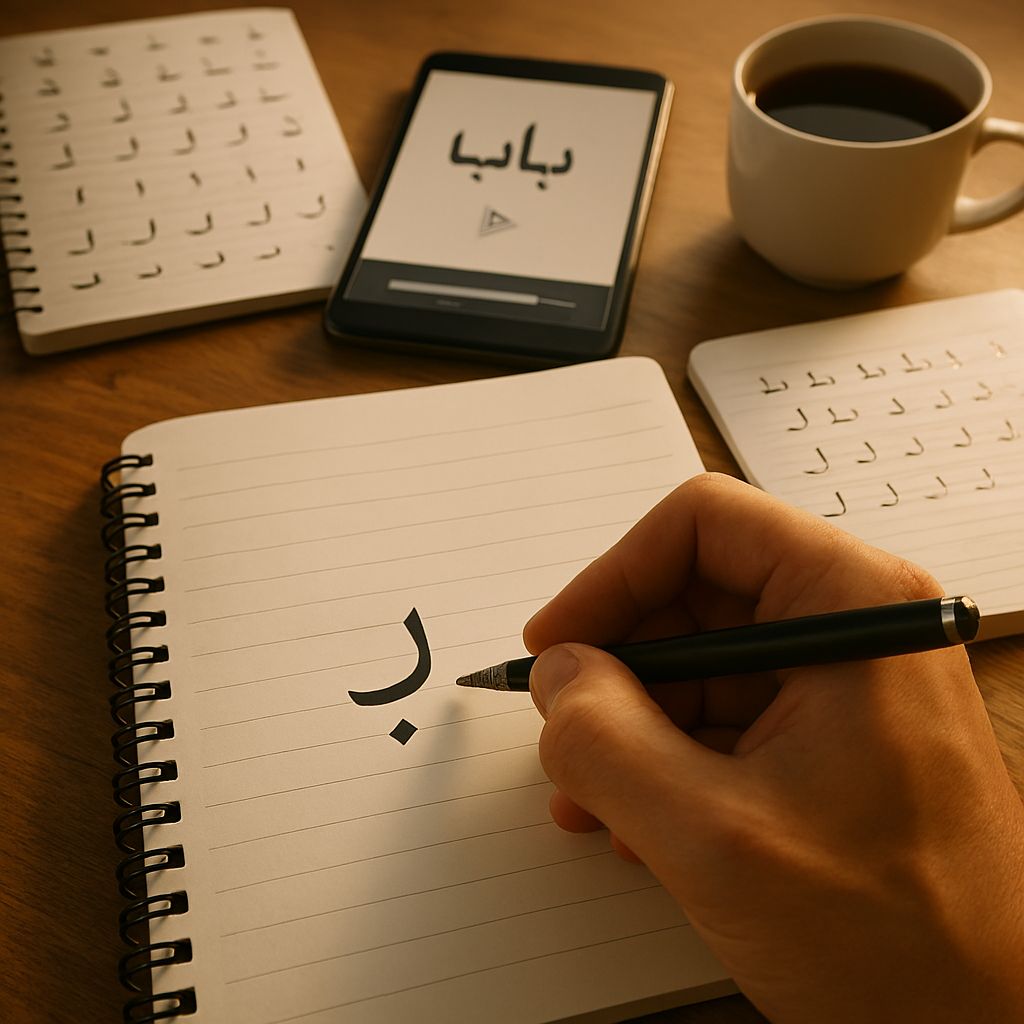
Beyond the Rules: Three Inspiring Journeys to Mastering Arabic
The stories that follow prove that “is Arabic hard to learn” has different answers for different people and purposes. When people ask “Is Arabic hard to learn?” they’re often looking for reassurance that their language journey is possible. While grammar books and vocabulary lists provide the roadmap, it’s the human stories that illuminate the path. Behind every successful Arabic learner lies a deeply personal transformation—one that extends far beyond linguistic competence into realms of cultural connection, professional opportunity, and self-discovery.
These real stories prove that ‘is Arabic hard to learn’ has different answers depending on your motivation and approach. The three journeys you’re about to read aren’t fairy tales. They’re authentic accounts of struggle, breakthrough, and triumph that reveal a profound truth: Arabic doesn’t just change how you communicate—it changes who you become. These stories prove that the question isn’t whether Arabic is difficult, but whether you’re ready for the extraordinary personal growth that comes with mastering this ancient and beautiful language.
The Artist: How Maria Found Her Voice Through Calligraphy
Maria’s journey shows that “is Arabic hard to learn” depends entirely on finding your personal connection to the language. Maria Rodriguez had always been drawn to visual arts, but her paintings felt incomplete—beautiful yet somehow voiceless. When she first encountered Arabic calligraphy at a cultural exhibition in Barcelona, she was mesmerized by the flowing scripts that seemed to dance across ancient manuscripts. “It wasn’t just writing,” she later recalled, “it was poetry made visible.” Her story reveals that ‘is Arabic hard to learn’ depends entirely on finding your personal connection to the language.
Her initial attempts at learning Arabic, however, were brutal. The script moved from right to left, letters changed shape depending on their position, and the sounds seemed to emerge from places in her throat she didn’t know existed. For months, she struggled with basic letter recognition, spending hours tracing ب and ت until her hand cramped. Her Spanish-speaking brain rebelled against the guttural sounds of ع and غ, and she often left her evening classes feeling defeated.
The breakthrough came during her fourth month of study, in the most unexpected way. Maria was practicing writing her name in Arabic—مارِيا—when her seven-year-old niece Sofia wandered into her studio. “Tía, it looks like a beautiful bird flying,” Sofia observed, tilting her head at the flowing letters. In that innocent moment, Maria saw what she’d been missing. She wasn’t just learning letters; she was learning to see language as movement, as art, as living expression.
That evening, Maria picked up her paintbrush and began incorporating Arabic script into her artwork. She painted ماء (water) in flowing blue strokes across her canvas, letting the meaning and form dance together. As her Arabic improved, so did her artistic vision. She learned that حب (love) could be painted in warm reds and golds, while سلام (peace) flowed in gentle greens across her canvases.
Two years later, Maria held her first solo exhibition: “Diálogos en Árabe” (Dialogues in Arabic). The gallery walls showcased forty paintings where Spanish and Arabic calligraphy intertwined, creating visual conversations between cultures. The opening night was magical—visitors from Madrid’s Arabic-speaking community approached her with tears in their eyes, moved by seeing their language honored as high art. One elderly Syrian refugee, Ahmad, stood before her painting of الوطن (homeland) for twenty minutes, finally whispering, “You understand. You truly understand.”
Today, Maria teaches Arabic calligraphy workshops across Spain, helping other artists discover the meditative beauty of this ancient script. “Arabic didn’t just give me new words,” she explains to her students, “it gave me new ways to see beauty in the world.”
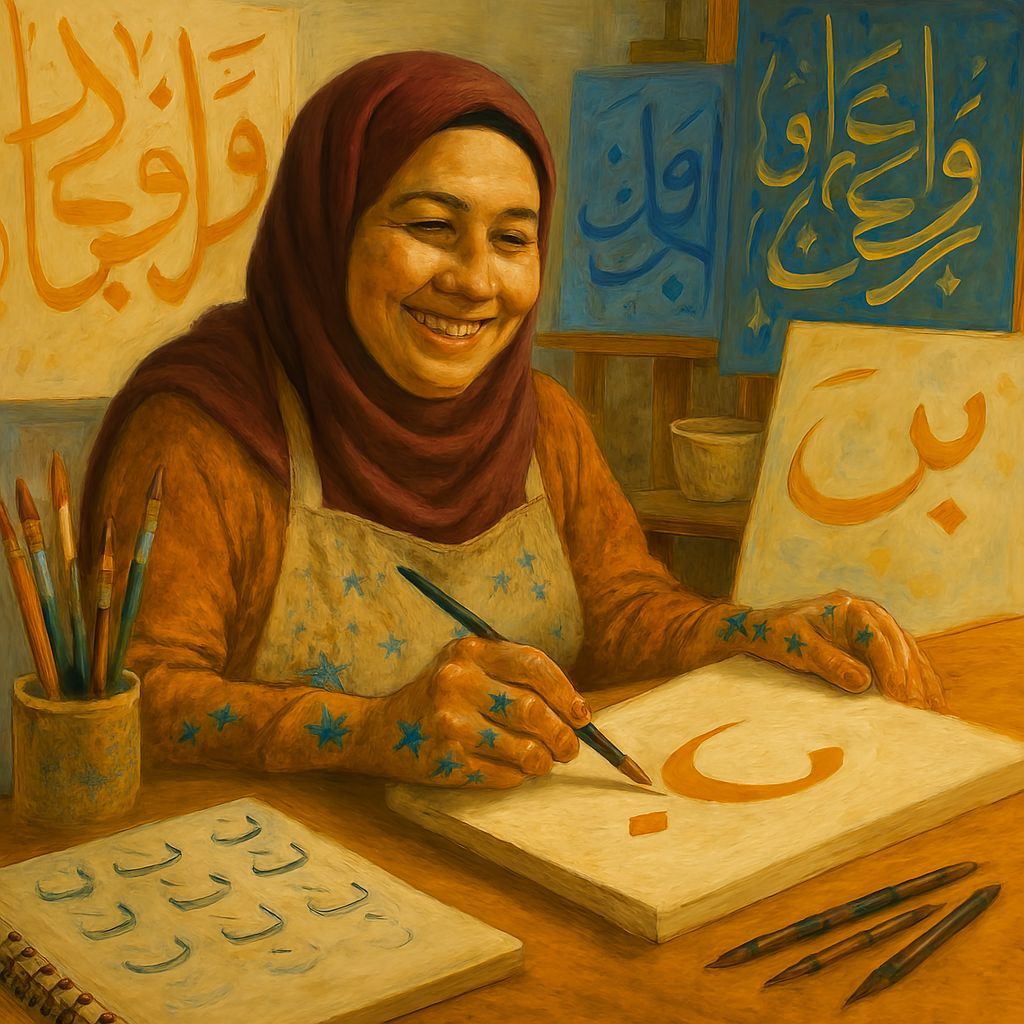
The Entrepreneur: How David Unlocked a New Market
David’s experience proves that “is Arabic hard to learn” isn’t the right question for business professionals—the question is how quickly you can start connecting with Arabic-speaking markets.
David Chen had built a successful tech startup in Silicon Valley, but expansion into Middle Eastern markets seemed impossible. His company’s AI-powered educational platform had potential across the Arabic-speaking world, but every business meeting felt like navigating a maze blindfolded. Translators helped with basic communication, but David sensed he was missing the cultural nuances that turn business discussions into partnerships.
David’s experience proves that for business professionals, ‘is Arabic hard to learn’ isn’t the right question—the question is how quickly you can start connecting. The decision to learn Arabic wasn’t romantic—it was strategic. But David’s engineering mindset, which served him well in coding, initially worked against him in language learning. He approached Arabic like debugging code, expecting logical patterns and consistent rules. Instead, he encountered a language rich with cultural context, emotional undertones, and subtle variations that couldn’t be programmed into neat algorithms.
His lowest point came during a Skype lesson with his Syrian tutor, Layla. David had been mechanically drilling verb conjugations for weeks, but when she asked him a simple question about his weekend plans—ماذا ستفعل في نهاية الأسبوع؟—he froze completely. Despite months of study, he couldn’t form a natural response. “David,” Layla said gently, “you’re learning Arabic like it’s code. But language is jazz—sometimes you have to improvise and feel the rhythm.”
The turning point came when Layla suggested he start watching Arabic Netflix series with subtitles. “Forget grammar for now,” she advised. “Just listen to how people actually talk.” David started with “Jinn,” a Jordanian supernatural thriller. At first, he caught maybe one word in ten, but gradually he began recognizing patterns—not grammatical patterns, but emotional ones. He noticed how speakers’ voices rose and fell, how they used repetition for emphasis, how silence carried as much weight as words.
Three months later, David flew to Dubai for a major partnership meeting. Instead of relying entirely on his translator, he began the meeting with a short introduction in Arabic, acknowledging his learning journey and his respect for the culture. His pronunciation was far from perfect, but something shifted in the room. The Emirati executives smiled genuinely for the first time, and the formal atmosphere melted into warm conversation.
The real magic happened during a coffee break. Khalid, the lead executive, approached David and switched to Arabic, speaking slowly and clearly. “أحترم محاولتك لتعلم لغتنا” (I respect your attempt to learn our language), he said. David understood every word and replied, haltingly but sincerely, about his journey and his hopes for cultural bridge-building through technology. That ten-minute conversation in broken but heartfelt Arabic secured a partnership worth $2.3 million.
Six months later, David’s platform launched across the Gulf states with unprecedented success. “Learning Arabic taught me that the best deals aren’t negotiated,” David reflects, “they’re built on mutual respect and understanding.”

The Grandson: How Leo Connected with His Heritage
Leo Mansouri grew up in Detroit feeling caught between worlds. His Lebanese grandfather, Jiddo Khalil, would speak to him in rapid-fire Arabic mixed with English, expecting understanding that Leo simply didn’t possess. Family gatherings became exercises in nodding politely while conversations flowed around him in a language that should have been his birthright but felt as foreign as ancient Sumerian.
Leo’s journey shows that when learning Arabic is about family connection, ‘is Arabic hard to learn’ becomes ‘how can I rebuild these precious relationships? The cultural disconnect deepened as Leo entered his twenties. He watched his cousins who had grown up in Beirut switch effortlessly between Arabic and English, sharing jokes and stories that flew over his head. Worse, he began to sense his grandfather’s disappointment—not harsh or critical, but a quiet sadness when Leo couldn’t engage with the family stories, the cultural references, or the emotional depths that only emerged in Arabic.
Leo’s attempts at learning Arabic in college were disasters. The formal Modern Standard Arabic taught in classrooms felt sterile compared to the warm, colloquial Lebanese dialect he heard at family dinners. He struggled with textbook phrases like “The student goes to the library” while desperately wanting to understand his grandmother’s stories about their village in the Bekaa Valley or his uncle’s passionate debates about Middle Eastern politics.
The catalyst came during his grandfather’s 85th birthday celebration. Jiddo Khalil, feeling nostalgic and surrounded by family, began recounting stories of his youth in Lebanon—the olive groves, the summer evenings, the songs they used to sing. But he told these stories in pure Arabic, his eyes bright with memory. Leo watched his grandfather’s face transform with joy as he shared these precious moments, but felt completely excluded from this intimate family history.
That night, Leo made a commitment. He found a Lebanese Arabic tutor online—Rima from Beirut—and explained his specific goal: he wanted to understand his grandfather’s stories. Rima restructured his learning around family conversations rather than textbook scenarios. Instead of learning “Where is the post office?” Leo learned “Tell me about the old days” (حكيلي عن الأيام القديمة).
Progress was slow but meaningful. Leo practiced by calling his grandfather weekly, starting conversations with phrases he’d rehearsed. “Jiddo, kifak?” (Grandpa, how are you?) became “Jiddo, shu akhbarik min libnan?” (Grandpa, what are your news from Lebanon?). Each conversation was a small victory, building Leo’s confidence and his grandfather’s delight.
The transformation moment arrived six months later during Ramadan. Leo’s grandfather was sharing memories of Ramadan evenings in their village, describing the sound of children playing in the streets after iftar. This time, Leo understood. Not every word, but enough to ask follow-up questions in Arabic: “Kam omrak ken wakton?” (How old were you then?) His grandfather’s face lit up with surprise and joy.
But the true magic happened when Leo responded to one of the stories with a memory of his own—about how his grandfather used to make him Arabic coffee when he was little, and how the smell always made him feel safe. He said it in halting Lebanese Arabic, mixed with English, but his grandfather understood perfectly. For the first time, they weren’t just grandfather and grandson—they were two men sharing family stories in the language of their ancestors.
Today, Leo serves as the family translator and bridge between generations. His Arabic isn’t perfect, but it’s real and meaningful. More importantly, he has become the keeper of family stories, recording his grandfather’s memories and translating them for younger cousins. “Arabic gave me back my grandfather,” Leo explains, “and through him, I found myself.”

The Ultimate Accelerator: Your Gateway to Getting Started
You now have the map—a clear, 20-step path to navigate the initial challenges of learning Arabic. You’ve heard the inspiring stories of Maria finding artistic expression, David building business bridges, and Leo connecting with his heritage. But what if you had a guide to walk the first mile with you? What if you could start this journey with absolute certainty, avoiding the common pitfalls and false starts that cause most learners to quit?
The question ‘is Arabic hard to learn’ becomes irrelevant when you have structured guidance and proven methods from day one. Imagine yourself one month from now. You’re not just staring at cryptic symbols; you’re reading and writing basic words with a confident hand. You’re not just mimicking sounds; you’re engaging in a simple, genuine exchange with a native speaker, and their face lights up because they understood you. That first moment of real connection is what makes every minute of practice worth it. This isn’t a distant dream; it’s the immediate result of taking structured, consistent action.
The question of “Is Arabic hard to learn?” becomes irrelevant when you have the right foundation. Your success depends not on natural talent or perfect conditions, but on taking that crucial first step with confidence and clarity.
Conclusion: Your Arabic Learning Journey Starts Now
You’ve seen the truth about learning Arabic: the challenges are real but entirely manageable, the approachable aspects are surprisingly accessible, and the rewards are profound. From mastering the elegant script to unlocking a rich cultural tapestry, the Arabic learning journey is a path worth taking. With a clear plan—focusing on consistent practice, immersive resources, and structured guidance—you can turn what seems daunting into an achievable goal.
The question “Is Arabic hard to learn?” has a clear answer: it’s only as hard as you make it. With the right tools and mindset, it’s a challenge you’re more than capable of conquering.
Throughout this comprehensive guide, we’ve transformed ‘is Arabic hard to learn’ from a barrier into a bridge toward your Arabic fluency. You now have everything you need to begin. You’ve seen the real challenges—the script, the sounds, and the structure—and learned exactly how to overcome each one. You’ve discovered the surprising advantages Arabic offers over other languages. You have a detailed 20-step roadmap that takes you from complete beginner to confident speaker. You’ve been inspired by real stories of transformation from Maria, David, and Leo, each finding their own path to Arabic fluency.
But most importantly, you’ve shifted your mindset. The question is no longer “Is Arabic hard to learn?” but “When do I start?”
The time for hesitation is over. Every moment you delay is a missed opportunity to connect with a language spoken by over 400 million people, to open doors to new cultures, careers, and perspectives. The only thing harder than learning Arabic is regretting you didn’t start sooner.
Your first step is simple: choose one action from Phase 1 of the 20-step plan and commit to it today. Download an alphabet app. Watch your first pronunciation video. Write Arabic letters for the first time. Label objects in your house. Start that conversation with a language partner.
Don’t let fear or doubt hold you back from this transformative journey. The Arabic language has survived and thrived for over 1,500 years, connecting diverse peoples across continents. It has room for you too.
The question “Is Arabic hard to learn?” is answered not with words, but with action. Your Arabic adventure is waiting—because you’re ready, and this ancient, beautiful language is ready to welcome you home.

